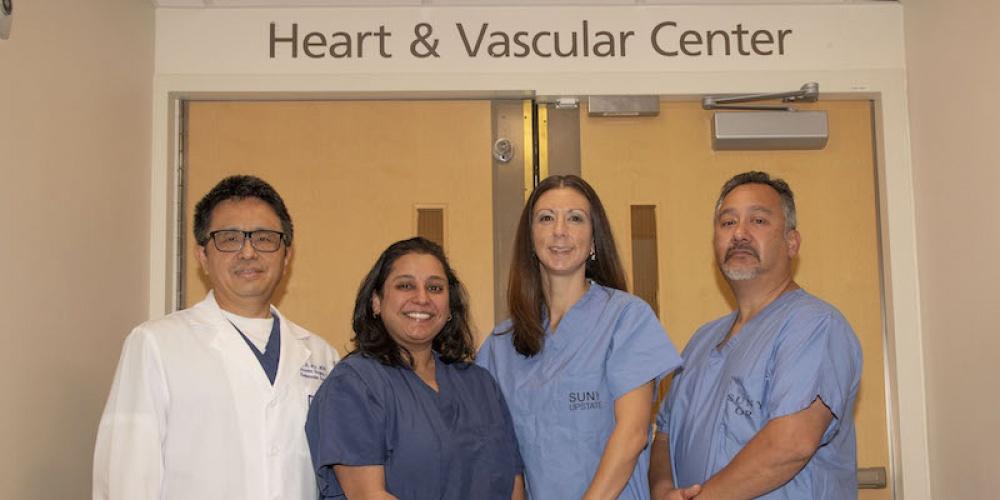New minimally invasive treatment helps Upstate patients with peripheral artery disease
A new vascular procedure to treat peripheral artery disease is now available at Upstate Medical University Hospital.
Peripheral artery disease (PAD) is a circulatory problem caused by blockages in the arteries, which can lead to a reduction in the flow of oxygenated blood, particularly to lower limbs. Traditional bypass surgical treatment requires long incisions and recovery time.
A new minimally invasive treatment, Percutaneous Transmural Arterial Bypass or PTAB using the DETOUR System by Endologix, can treat some types of PAD by using the femoral vein to bypass blockages in the superficial femoral artery, restoring blood flow to the affected area.
“This disease is very common,” said Upstate vascular surgeon Wei Li, MD. “Until now more traditional open surgical approaches leave patients with long incisions in their legs, long recovery time and a more painful experience.”
Li is one of a select group of doctors around the country included in a targeted market release of the DETOUR System, and according to the company, Upstate is one of the few hospitals in the nation to offer it. At the time of Li’s first use of the new system, his surgery was only the 28th nationwide.
According to Endologix, 8.5 million adults have lower extremity PAD. The new treatment, Percutaneous Transmural Arterial Bypass (PTAB) using the DETOUR System can treat some types of PAD above the knee by using the femoral vein to bypass blockages in the superficial femoral artery, restoring blood flow to the affected area.
PAD symptoms include coldness in the lower leg or foot, especially when compared with the other side, leg numbness or weakness, no pulse or a weak pulse in the legs or feet and painful cramping in one or both of the hips, thighs or calf muscles after certain activities, such as walking or climbing stairs. An ankle-brachial index (ABI), which compares the blood pressure in the ankle with the blood pressure in the arm, is a common test used to diagnose it.
Using the DETOUR System, with fluoroscopic guidance, doctors bypass lesions in the superficial femoral artery by using stents routed through the femoral vein to restore blood flow to the leg. By using the femoral vein as a conduit, the diseased superficial femoral artery is bypassed.
This approach is particularly effective for patients with long lesions, patients who have already undergone failed endovascular procedures, or patients who may be suboptimal candidates for open surgical bypass.
Li adds that this treatment is helpful for older patients with comorbidities who can’t tolerate a traditional long surgical incision. He said it can even eliminate the need for patients to need rehab.
The development of the DETOUR System has been guided by data, including two multicenter, international studies. Clinical evidence demonstrates PTAB, using the DETOUR System, is an effective treatment option for patients with long complex superficial femoral artery disease.
Li’s first patient came from Auburn where Li’s practice an outreach clinic and a collaboration and joint partner effort with the Auburn Community Hospital to serve the underserved population in that area. The patient had two separate issues and a complex pathology and Li said the use of the DETOUR System allowed him to fix the problem much more easily.
“Otherwise, he would have been treated much more aggressively and had a much more invasive open surgery,” Li said. “The patient was very happy and went home.”
Li predicts the new procedure will be revolutionary.
“The procedure will change the landscape of the treatment of leg circulation (lower extremity revascularization), which represents a very large portion of vascular patients,” Li said.
Li joined Upstate earlier this year from the Texas Tech University Health Sciences Center. There, Li made headlines in 2021 in the West Texas and Eastern New Mexico when he became the first physician in the region to repair an aortic aneurysm with a FEVAR technique. (https://www.kcbd.com/2021/03/03/ttuhsc-physician-first-region-perform-procedure/) He also performed a novel thoracic endovascular aortic repair, which was reported in the Journal of Vascular Surgery Cases, Innovations and Techniques https://www.ncbi.nlm.nih.gov/pmc/articles/PMC8560835. The patient who benefited from the surgery traveled from Texas to Syracuse for an appointment with Li less than two months ago (https://www.upstate.edu/news/articles/2023/2023-10-05-benton.php).
Caption: Among the team who performed the first PTAB using the DETOUR systems are, from left, vascular surgeon Wei Li, MD, senior vascular surgery fellow Shilpa Agarwal, MD, MPH, and Heart and Vascular Center senior technicians Nicole Seymour and Gonzalo Lozano.

